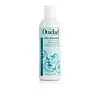What's inside
What's inside
 Key Ingredients
Key Ingredients

No key ingredients
 Benefits
Benefits

 Concerns
Concerns

 Ingredients Side-by-side
Ingredients Side-by-side

Water
Skin ConditioningCetyl Alcohol
EmollientStearyl Alcohol
EmollientCitrus Grandis Fruit Extract
AstringentCitrus Aurantium Dulcis Fruit Extract
MaskingMangifera Indica Fruit Extract
Skin ConditioningRosmarinus Officinalis Leaf Extract
AntimicrobialChamomilla Recutita Flower Extract
MaskingGlycine Soja Seed Extract
Skin ConditioningMacrocystis Pyrifera Extract
Skin ConditioningCymbopogon Schoenanthus Extract
Skin ConditioningHydrolyzed Soy Protein
HumectantAloe Barbadensis Leaf Juice
Skin ConditioningHelianthus Annuus Seed Oil
EmollientTocopheryl Acetate
AntioxidantPhenoxyethanol
PreservativeSimmondsia Chinensis Seed Oil
EmollientCetrimonium Bromide
AntimicrobialParfum
MaskingEthylhexylglycerin
Skin ConditioningWater, Cetyl Alcohol, Stearyl Alcohol, Citrus Grandis Fruit Extract, Citrus Aurantium Dulcis Fruit Extract, Mangifera Indica Fruit Extract, Rosmarinus Officinalis Leaf Extract, Chamomilla Recutita Flower Extract, Glycine Soja Seed Extract, Macrocystis Pyrifera Extract, Cymbopogon Schoenanthus Extract, Hydrolyzed Soy Protein, Aloe Barbadensis Leaf Juice, Helianthus Annuus Seed Oil, Tocopheryl Acetate, Phenoxyethanol, Simmondsia Chinensis Seed Oil, Cetrimonium Bromide, Parfum, Ethylhexylglycerin
Water
Skin ConditioningCetearyl Alcohol
EmollientBehentrimonium Chloride
PreservativeBehentrimonium Methosulfate
Glycerin
HumectantChamomilla Recutita Flower Extract
MaskingEchinacea Purpurea Extract
MoisturisingCitrus Medica Limonum Peel Extract
EmollientLaminaria Digitata Extract
Skin ProtectingAloe Barbadensis Leaf Juice
Skin ConditioningWheat Amino Acids
Skin ConditioningHydrolyzed Keratin
HumectantAmodimethicone
Panthenol
Skin ConditioningLinoleamidopropyl Ethyldimonium Ethosulfate
Dimethyl Lauramine Isostearate
EmollientCetrimonium Chloride
AntimicrobialPolyquaternium-37
Polyquaternium-7
Propylene Glycol Dicaprylate/Dicaprate
EmollientTrideceth-6
EmulsifyingTrideceth-12
EmulsifyingHexylene Glycol
EmulsifyingCaprylyl Glycol
EmollientPhenoxyethanol
PreservativeParfum
MaskingAlpha-Isomethyl Ionone
PerfumingGeraniol
PerfumingHexyl Cinnamal
PerfumingLimonene
PerfumingLinalool
PerfumingWater, Cetearyl Alcohol, Behentrimonium Chloride, Behentrimonium Methosulfate, Glycerin, Chamomilla Recutita Flower Extract, Echinacea Purpurea Extract, Citrus Medica Limonum Peel Extract, Laminaria Digitata Extract, Aloe Barbadensis Leaf Juice, Wheat Amino Acids, Hydrolyzed Keratin, Amodimethicone, Panthenol, Linoleamidopropyl Ethyldimonium Ethosulfate, Dimethyl Lauramine Isostearate, Cetrimonium Chloride, Polyquaternium-37, Polyquaternium-7, Propylene Glycol Dicaprylate/Dicaprate, Trideceth-6, Trideceth-12, Hexylene Glycol, Caprylyl Glycol, Phenoxyethanol, Parfum, Alpha-Isomethyl Ionone, Geraniol, Hexyl Cinnamal, Limonene, Linalool
Ingredients Explained
These ingredients are found in both products.
Ingredients higher up in an ingredient list are typically present in a larger amount.
Aloe Barbadensis Leaf Juice comes from leaves of the aloe plant. Aloe Barbadensis Leaf Juice is best known for helping to soothe sunburns. It is also anti-inflammatory, moisturizing, antiseptic, and can help heal wounds.
Aloe is packed with good stuff including Vitamins A, C, and E. These vitamins are antioxidants, which help fight free-radicals and the damage they may cause. Free-radicals are molecules that may damage your skin cells, such as pollution.
Aloe Barbadensis Leaf Juice also contains sugars. These sugars come in the form of monosaccharides and polysaccharides, folic acid, and choline. These sugars are able to help bind moisture to skin.
It also contains minerals such as calcium, 12 anthraquinones, fatty acids, amino acids, and Vitamin B12.
Learn more about Aloe Barbadensis Leaf JuiceChamomilla Recutita Flower Extract comes from the Chamomile flower.
Chamomile is rich in antioxidants and has anti-inflammatory properties. Several compounds found in chamomile help with soothing, such as bisbolol.
Antioxidant components in chamomile make it an effective ingredient to help slow the signs of aging. Antioxidants help fight free-radical molecules, or molecules that may damage your skin.
Essential oils from chamomile have been found to improve wound healing due to its antimicrobial properties.
Ancient Greeks and Egyptians used Chamomile to treat skin redness and dryness. Chamomile has also been used to help treat stomach issues.
Learn more about Chamomilla Recutita Flower ExtractParfum is a catch-all term for an ingredient or more that is used to give a scent to products.
Also called "fragrance", this ingredient can be a blend of hundreds of chemicals or plant oils. This means every product with "fragrance" or "parfum" in the ingredients list is a different mixture.
For instance, Habanolide is a proprietary trade name for a specific aroma chemical. When used as a fragrance ingredient in cosmetics, most aroma chemicals fall under the broad labeling category of “FRAGRANCE” or “PARFUM” according to EU and US regulations.
The term 'parfum' or 'fragrance' is not regulated in many countries. In many cases, it is up to the brand to define this term.
For instance, many brands choose to label themselves as "fragrance-free" because they are not using synthetic fragrances. However, their products may still contain ingredients such as essential oils that are considered a fragrance by INCI standards.
One example is Calendula flower extract. Calendula is an essential oil that still imparts a scent or 'fragrance'.
Depending on the blend, the ingredients in the mixture can cause allergies and sensitivities on the skin. Some ingredients that are known EU allergens include linalool and citronellol.
Parfum can also be used to mask or cover an unpleasant scent.
The bottom line is: not all fragrances/parfum/ingredients are created equally. If you are worried about fragrances, we recommend taking a closer look at an ingredient. And of course, we always recommend speaking with a professional.
Learn more about ParfumPhenoxyethanol is a preservative that has germicide, antimicrobial, and aromatic properties. Studies show that phenoxyethanol can prevent microbial growth. By itself, it has a scent that is similar to that of a rose.
It's often used in formulations along with Caprylyl Glycol to preserve the shelf life of products.
Water. It's the most common cosmetic ingredient of all. You'll usually see it at the top of ingredient lists, meaning that it makes up the largest part of the product.
So why is it so popular? Water most often acts as a solvent - this means that it helps dissolve other ingredients into the formulation.
You'll also recognize water as that liquid we all need to stay alive. If you see this, drink a glass of water. Stay hydrated!
Learn more about Water